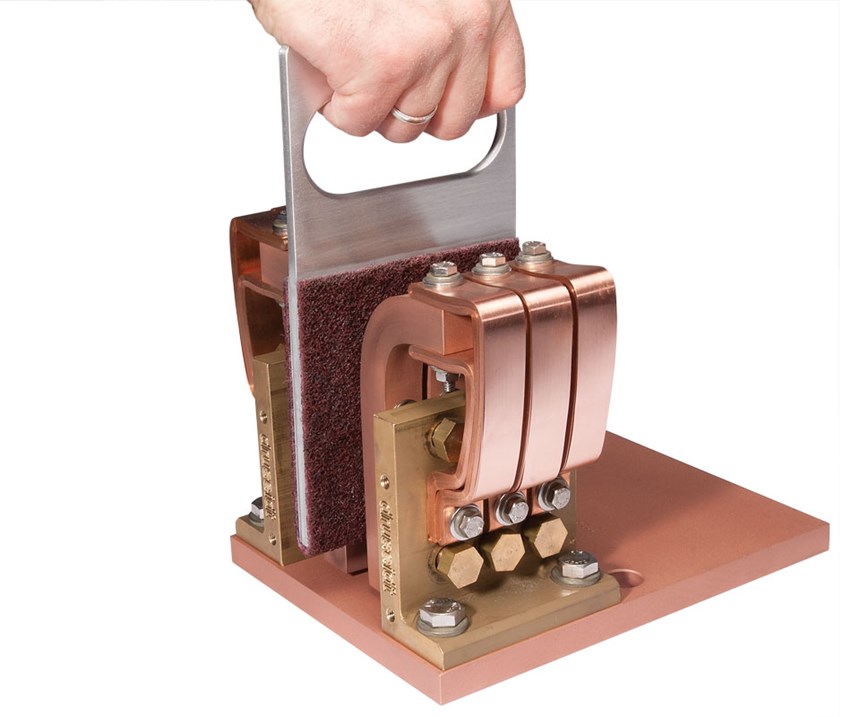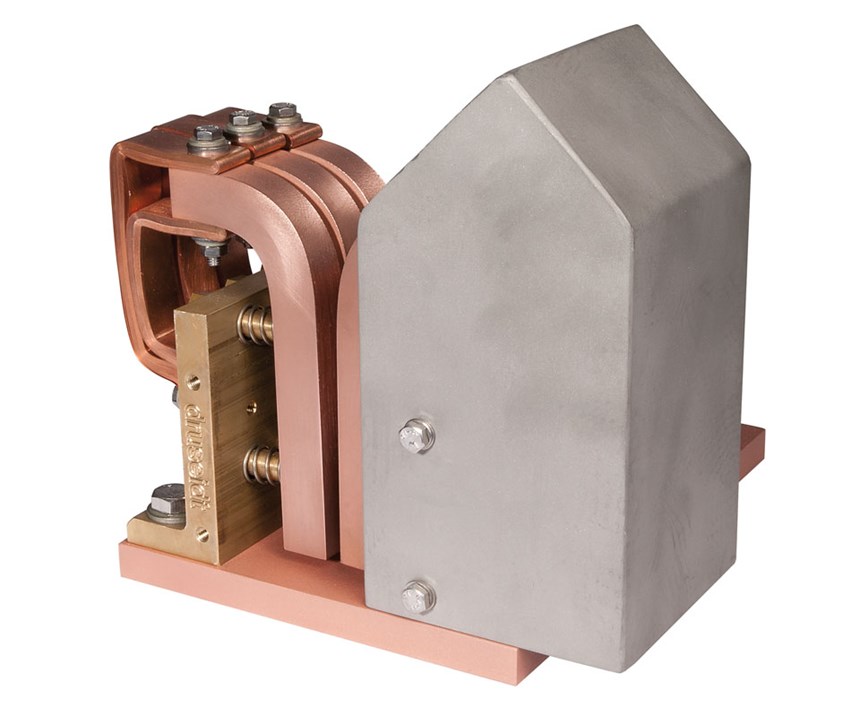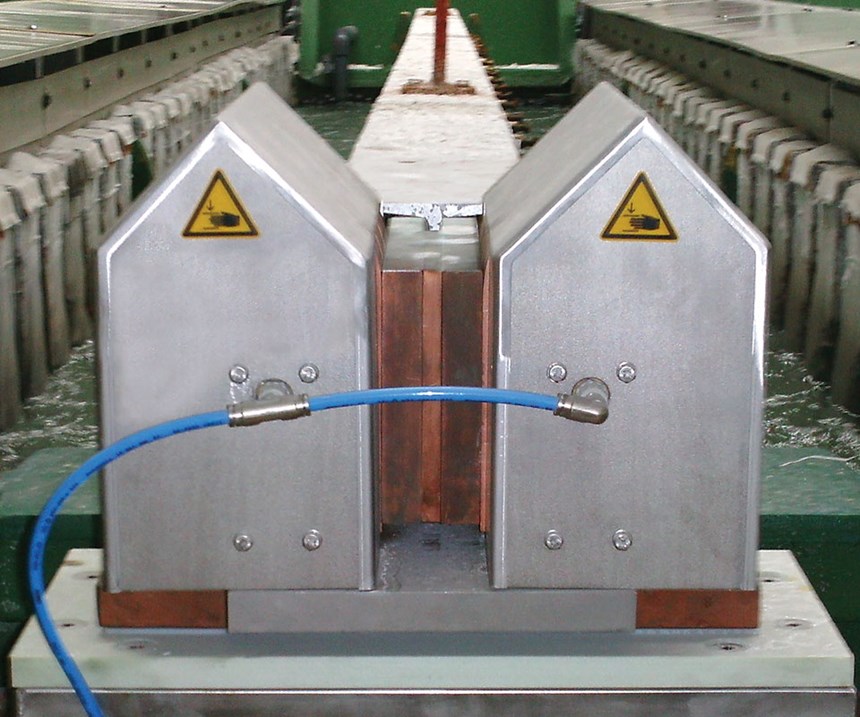Making Contact with Your Plating Line
Picking the right electrical contact system is important for proper plating line optimization.
Choosing the right electrical contact system can be one of the most important decisions for a plating operation. Plating shops use high-current rectifiers and are large energy consumers. Poor power distribution and inefficient contacts are often the key factors driving large electrical losses, quality problems and costly plant shutdowns.
Not only are contacts exposed to high electrical currents, but they also are subject to mechanical and aggressive chemical abuse. A new and clean electrical contact system may perform well, but after a year or so of use, it will perform much differently. It’s essential that the contact area transmit the current with minimal electrical loss on its way to the rack and, more specifically, to the components that are being plated or anodized in the tanks.
Contact saddles often are specified with a simple bronze-casting V-block design, but this critical contact junction sometimes does not have a large enough surface area or electrical cross section to meet the high current requirements of the rectifier.
New contact and power distribution systems are being designed to meet those technical demands, however, as well as to address issues of chemical corrosion and contact cleaning. No one contact design would work perfectly with every plating application, however, as there are many different tank construction and design philosophies. The most common flight bar shape, for example, is rectangular, in a variety of thicknesses and heights, and they demand specialized contacts in order to work efficiently. In some cases, extreme chemical exposure requires special consideration to ensure proper contact over a longer period of time. And the availability of adequate space for contact placement on a tank rim may also require a custom design or modification.
Considerations for a New System
There are a number of important factors to consider in selecting new contacts:
- Amperage or current requirement.
- Length of each cycle time.
- Weight and dimensions of flight bars with racks.
- Profile and dimensions of flight bars’ contact areas.
- Special or extreme chemical exposure.
- Possible mechanical forces.
- Possible tank movement.
- Available space for installation.
A fire in a plating plant is not unheard of, and many workers in these shops have smelled and felt the heat from overheated flight bars and contact saddles. It’s not uncommon for flight bars, contact saddles, base plates, cables and electrical bus bars to be warm to the touch, but hot is unacceptable, and will put the plant and personnel at high risk for injury. High heat is generated from the rectifier to the bus bars, in cables from the bus bars to the contacts, as well as in the interface between the flight bar and the contact saddle. Cables, particularly if they contain too small a cross section of copper and are inadequately sized, or if they are frayed, worn, chemically burned or have improperly crimped lugs, are many times the culprit when fire erupts.
Often, the single most critical area of high heat generation is at the point where the flight bar and the contact saddle meet during the transfer of electrical power; in the case of a V-block contact saddle and a round bar, this interface would be only two thin lines of contact. In addition to temperatures high enough to cause fires or burn employees, a great amount of energy and current are lost in travelling to the parts on the rack, and this can adversely affect the time and deposition rate of plating.
Many shops use an upside-down J channel or shepherd’s hook design at the top end of the racks’ arms for hanging off the bus bar. This is also an area of little surface contact, which leads to a reduced current flow. Rack contacts with a V design ensure that the contact area is large and consistent, easily alleviating this problem.
Spring-loaded Contacts
Spring-loaded contact systems are available for amperages ranging to 14,000 amps. These systems are based on two spring-mounted contact fingers on parallel contact halves. The distance between the spring-loaded fingers is slightly smaller than the rack, thus allowing the contact surfaces to be cleaned by abrasion. The weight of the bus bar when lifting allows it to be easily removed with little resistance from the fingers. Additionally, stainless steel covers protect the fingers from the plating chemicals while also acting as centering guides for movements such as a swinging flight bar as it enters the contact block. This contact block system is relatively inexpensive and can be designed in a variety of sizes ranging to 5,000 amps per contact block; a reinforced cast block with integrated guides for amperages to 14,000 amps also is available.
Pneumatically controlled contact blocks are the next step toward increasing current transfer. Available in a finger contact design or a plate contact design, they are designed for transferring large currents as well as for very light flight bars.
Poor contact pressure at a clamping connection combined with the cross section, material and surface condition, are the essential factors responsible for electrical resistance and power losses. Electrical resistance decreases with increased pressure, brought about by the further evolution of the contact block using hydro-pneumatic power. This allows clamping pressure as strong as 10 tons for a 5,000-amp contact at 90 psi. This clamping pressure is exponentially higher than with a spring-loaded or pneumatically controlled contact block, making them ideal for transferring current in applications ranging from 3,000 to 15,000 amps and more.
Achieving Consistent Quality
Consistent quality in any plating process is negatively affected by corrosion. Exposing contact surfaces to this environment leads to increased electrical resistance, heat-related problems and even the destruction of individual components. Optimizing automated process flow, and minimizing repair and maintenance costs requires cleaning systems. Hand cleaners can quickly clean finger contacts or other contact surfaces, and flight bar supports at the rinsing tanks can also be substituted with cleaning saddles, ensuring that the flight bar is automatically cleaned before the next plating or anodizing cycle.
Overall, specifying the correct contact saddles, rack contacts and adequately sized cable connectors are important factors in full optimization of a plating or anodizing facility. By taking the time to make an informed decision up front, shops can save time and money, and improve production in the future.
About the Author
A.J. Schenk
A.J. Schenk is vice president of sales for Intercon Enterprises, which partners with Druseidt Electrotechnik of Remscheid, Germany, to offer products and services to the North American market. Visit intercon1978.com.
Related Content
How to Choose Between Sulfate and Chloride-Based Trivalent Chromium
There are several factors to consider when choosing between sulfate and chloride-based baths for trivalent chromium plating. Mark Schario of Columbia Chemical discusses the differences and what platers should keep in mind when evaluating options.
Read MoreTrivalent Chrome Overview
As the finishing industry begins to move away from the use of hexavalent chromium to trivalent chromium, what factors should finishers consider as they make new investments? Mark Schario, chief technology officer for Columbia Chemical offers a helpful overview of this complicated topic.
Read MoreInnovation in Plating on Plastic
Plating on advanced plastics solution offers improved adhesion, temperature resistance and cost savings.
Read More3 Tests to Ensure Parts are Clean Prior to Plating
Making sure that all of the pre-processing fluids are removed prior to plating is not as simple as it seems. Rich Held of Haviland Products outlines three tests that can help verify that your parts are clean.
Read MoreRead Next
Education Bringing Cleaning to Machining
Debuting new speakers and cleaning technology content during this half-day workshop co-located with IMTS 2024.
Read MoreA ‘Clean’ Agenda Offers Unique Presentations in Chicago
The 2024 Parts Cleaning Conference, co-located with the International Manufacturing Technology Show, includes presentations by several speakers who are new to the conference and topics that have not been covered in past editions of this event.
Read MoreMasking Solutions for Medical Applications
According to Custom Fabricating and Supplies, a cleanroom is ideal for converting, die cutting, laminating, slitting, packaging and assembly of medical-grade products.
Read More

























